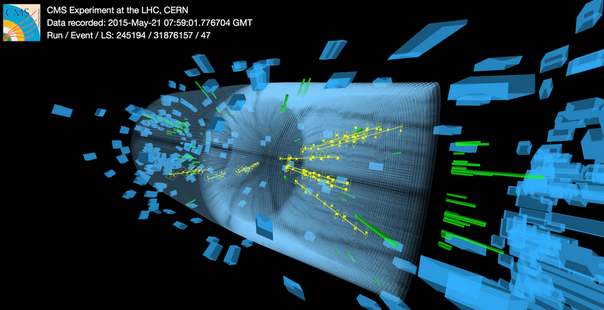The picture below shows one such collision, as recorded by the CMS experiment today. The blue boxes show the energy recorded in the calorimeter, which measures particle energy by "destroying" them as they interact with the dense layers of matter that this device is made up of; the yellow curves show tracks reconstructed by the ionization deposits of charged particles left in the silicon detector layers of the inner tracker.
For more pictures from CMS, see here.

Bang... The highest-energy man-made collision between subatomic particles ever achieved by mankind!
... But wait. Is that so, really ?
Please answer by yourself, by picking one among the following, and reporting your answer (if you wish with a comment) in the comments thread!
1) Yes! Everybody says so, I even read it on my local newspaper.
2) No, because some collision between proton beams and very energetic cosmic rays has produced detectable events with much higher energy in the past. Some cosmic rays hit us with energy many orders of magnitude higher than that of the LHC.
3) No, because we collided lead ions and other ions at energies of 2.76 TeV per nucleon, which is much higher than the 13 TeV achieved today. It is actually an order of magnitude higher!
4) No, because what matters is the energy available for creation of new states of matter in the center-of-mass system, which depends on the unknown momentum fraction of the partons. And we have collected much more collisions at 8 TeV three years ago, some of which are way more energetic than those produced today.
5) No, because the image above is the result of a simulation; CERN is just doing PR. The true collisions will not occur before next month.
Only one of the above is correct. I will tell you which one and why tomorrow.




Comments